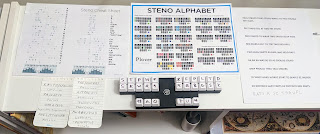Monday, May 29, 2023
Monday, May 22, 2023
Numbers and Symbols Demonstration Video
As Peter of StenoKeyboards says (and demonstrates) in this video, you can write anything with steno! Anything!!
Monday, May 15, 2023
More Ruby Steno Coding: Paul Solves the Bob Problem
Paul says:
This is my attempt at solving the "Bob" problem from Exercism's Ruby track in a test-driven (red-green-refactor) way using Plover stenography.
Monday, May 8, 2023
Steno Pedagogy!
I'm not quite sure how or why, but my 6-year-old's interest in learning steno has recently been reignited! Kind of flying by the seat of my pants in terms of best practices for steno pedagogy, so any advice would be very welcome. So far he's been asking me how to write particular words and I've been writing the steno down for him, plus I gave him a list of easy sentences to write on the be-Javelined Uni that connects to his Chromebook, and he's managed to write pretty much all of them perfectly! It's very exciting.
Monday, May 1, 2023
Can You Write Short Using Plover Theory?
A bit of a digression this week, if you'll indulge me. Recently on the Discord
someone asked if Plover Theory was good enough for professional use. Well, I use
it, I replied. And I'm a professional. Some people worried that it might not be
a "short enough" theory. I answered that most people tend to "write out" more
when they start steno and then find that their writing gradually becomes shorter
and more efficient over time, as they make their own briefs for common words
used in their own particular field of work. By way of demonstration, I offered a
paragraph that I'm able to write using my current personal dictionary (which is
several years newer than the dictionary distributed with Plover) in at most one
stroke per word:
And between heterochromatin, heterochromatin can spread on DNA. We talked a little bit about that, I think. How H3K9 methylation can modify neighboring histones, neighboring nucleosomes, and allow with the help of HP1 protein to spread heterochromatin. There's something called a barrier sequence, which is in fact related to an insulator, that will block the spread of heterochromatin. That leaves euchromatin, the actively transcribed regions. A key factor that works in these kinds of elements, insulators and barriers, is an 11 zinc finger repressor protein. You know we've talked about zinc fingers, proteins that contain multiple zinc fingers.I caption a lot of biology material -- biochemistry, molecular biology, computational and microbial genomics, etc -- and have made briefs that allow me to do it quickly and efficiently. My strokes for the paragraph above are as follows:
SKP: and TWAOEPB: between HO*ERPBT: heterochromatin KW-BG: {,} HO*ERPBT: heterochromatin K: can SPRED: spread OPB: on TK*PB: DNA TP-PL: {.} WAOE: we TAUBGD: talked PWHR-BLT: a little bit PW: about THA: that KW-BG: {,} EU: I THEU: think TP-PL: {.} HOU: how HAOEFPB: H3K9 PH*EFGS: methylation K: can PHO*FD: modify TPHA*EUBG: neighboring HO*EFPBTS: histone {^s} KW-BG: {,} TPHA*EUBG: neighboring SKHROEPLS: nucleosome {^s} KW-BG: {,} SKP: and HRO*U: allow W: with -T: the HEP: help -F: of HAO*EFPB: HP1 PRAO*EPB: protein TO: to SPRED: spread HO*ERPBT: heterochromatin TP-PL: {.} THR-S: there's S-G: something KAULD: called AEU: a PWR*ER: barrier SKWEPBS: sequence KW-BG: {,} WEU: which S: is TPH: in TPABGT: fact RAELTD: related TO: to APB: an SHRO*ERT: insulator KW-BG: {,} THA: that HR: will PWHROBG: block -T: the SPRED: spread -F: of HO*ERPBT: heterochromatin TP-PL: {.} THA: that HREFS: leaves KWRO*EPLT: euchromatin KW-BG: {,} -T: the TAEFL: actively TREUBD: transcribed RAOEGSZ: region {^s} TP-PL: {.} AEU: a KAOE: key TPARBGT: factor THA: that WORBGS: works TPH: in THAOES: these KAOEUPBDZ: kinds -F: of HREPLTS: elements KW-BG: {,} SHRO*ERTS: insulator {^s} SKP: and PWR*ERS: barriers KW-BG: {,} S: is APB: an 1-D: 11 STKPWEURPBG: zinc finger RERP: repressor PRAO*EPB: protein TP-PL: {.} U: you TPHOE: know WAOEF: we've TAUBGD: talked PW: about STKPWEURPBGS: zinc fingers KW-BG: {,} PRAO*EPBS: proteins THA: that TAEUPB: contain PH-PL: multiple STKPWEURPBGS: zinc fingers TP-PL: {.}I hope this example makes it clear that the briefing techniques taught by the various Plover Theory learning materials can be applied to any domain of knowledge, and that when you've got a firm grasp on the jargon that you're writing and on the mnemonic pathways of your own particular brain, Plover Theory can be used to write very short indeed.
Subscribe to:
Posts (Atom)

